Trip to Mahabalipuram, Tamilnadu on December 5, 2007
Adi Varaha Temple
One of the finished monuments, this
temple is currently under worship. A stucco image of Varaha has been
installed in the garbagraham. This must be a later addition.
A wall has been raised which covers the front of the mandapam and therefore
we are not able to see the pillars and most of the roof from the outside.
Usually, a row of pillars divides the mandapam into two sections – the
maha mandapam & ardha mandapam on the inner side. In this mandapam,
there are two rows of pillars. In the first row, are four pillars
and two pilasters with sitting lion base. In the second row are two
pillars.
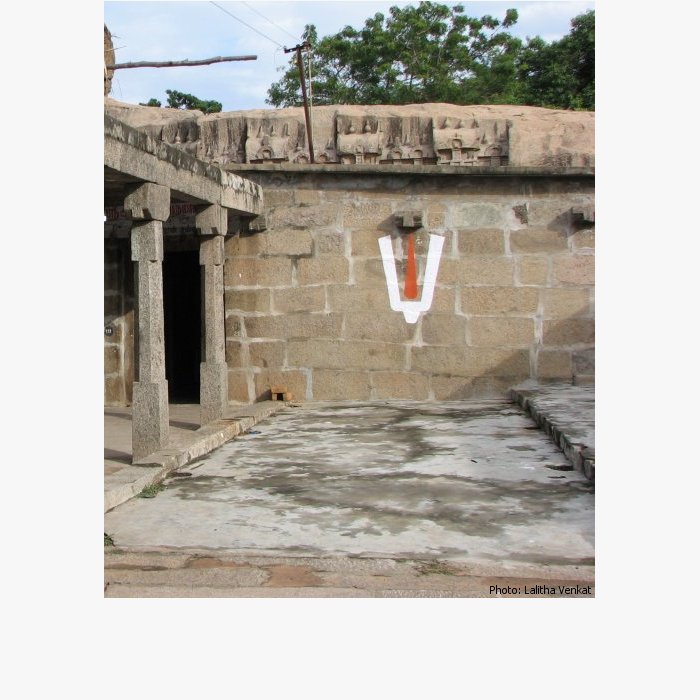
Adi Varaha Temple, Mahabalipuram, Tamilnadu
There are several relief panels
to be seen in this mandapam, some of them similar to those in the Varaha
Mandapam – Gangadhara, a Pallava king (seated on a throne) with his queens,
Gajalakshmi, Vishnu, Harihara, Durga, another panel depicting a Pallava
king (standing) with his queens, Brahma.
Gangadhara panel
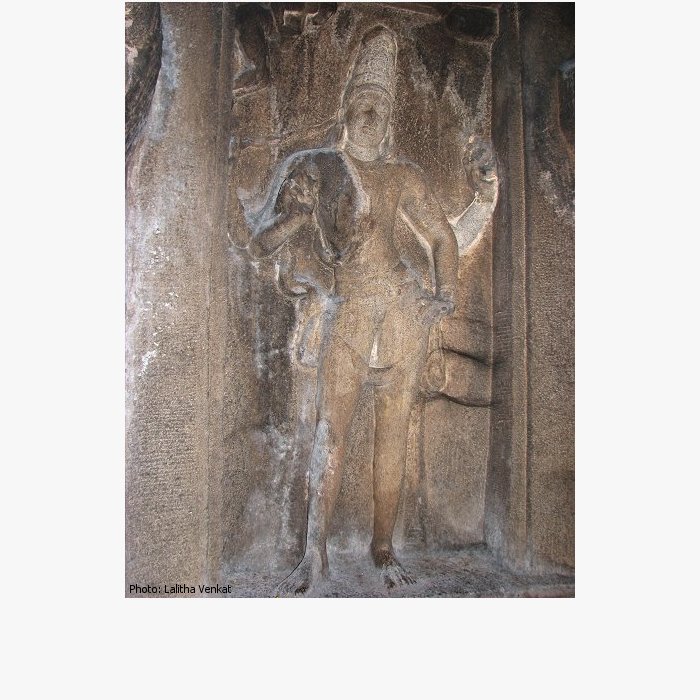
Siva is seen standing holding out
a strand of hair to receive the descending Ganges. Ganga is shown
as a woman falling down, offering prayers to Lord Siva. Siva is seen
with four arms - main right arm in abhaya mudra (blessing) and the main
left arm on his hips, weapons in his upper arms.
Adi Varaha Temple, Mahabalipuram, Tamilnadu
Gangadhara panel
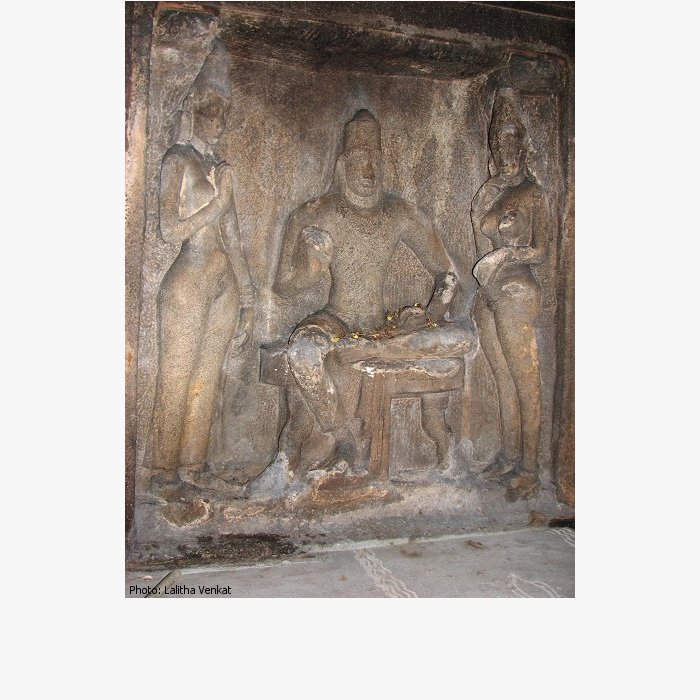
Adi Varaha Temple, Mahabalipuram, Tamilnadu
Pallava king
A wide shouldered Pallava king is
seen seated on a throne. Though he wears a crown, there are not many
ornaments on his chest. On either side are his queens facing the
king, seen in three-fourth profile.
There is an inscription on the lintel
reading sri-simhavinna-pottr-Athirajan ('The illustrious Simhavishnu-Pallava,
Supreme King') in Pallava Grantha characters.
Majority view is that it is Simhavishnu,
the grand-father of Mamalla. But, one scholar suggests that it is Rajasimha
and his queens.
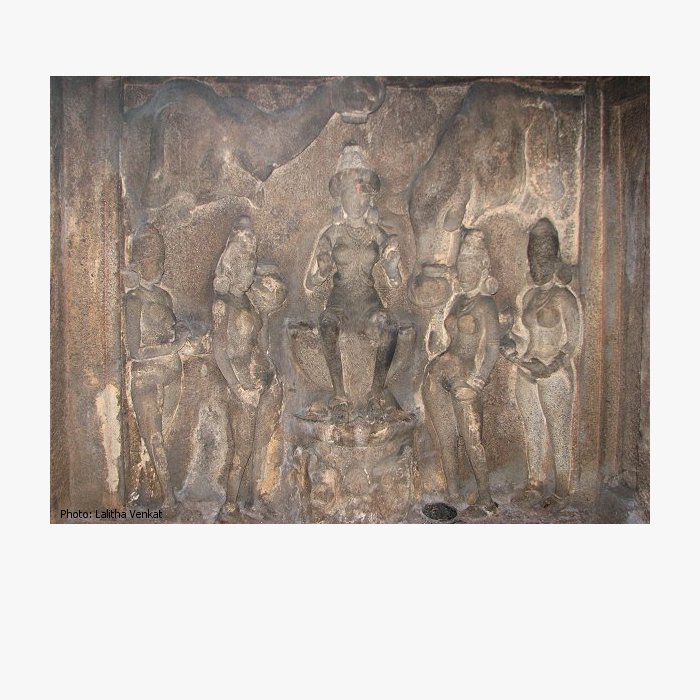
Adi Varaha Temple, Mahabalipuram, Tamilnadu
Gajalakshmi Panel
Lakshmi is seated erect on a lotus.
She is seen holding lotuses in both her arms with her legs resting on the
lotus. There are four women, two on either side. The ones closest
to Lakshmi are holding pots ready for the holy bath. The other two women
are holding flowers in their hands. There are two huge elephants on top.
The one on the left is in the act of squirting holy water on Lakshmi and
the one on the right is ready to reach the pot.
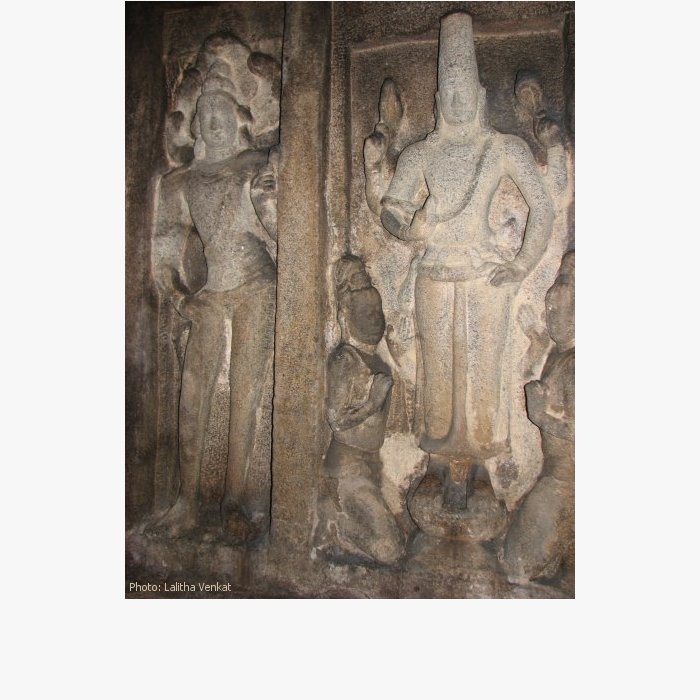
To the right of the Lakshmi panel
is a Vishnu sculpture in a niche, standing on a lotus with four
arms. There are two devotees kneeling at his feet. Outside
the niche is the figure of Adisesha with five heads (snake's hood) to Vishnu's
right.
To the right of this panel is the
garbagriham with two dwarapalakas at the entrance. On the
beam is a hamsa (swan) frieze. On the rear wall is a relief panel
of Varaha. There are also the figures of Sri Devi and Bhu Devi in
the shrine. A stucco image of Varaha has been installed. This must
be a later addition.
Adi Varaha Temple, Mahabalipuram, Tamilnadu
Vishnu
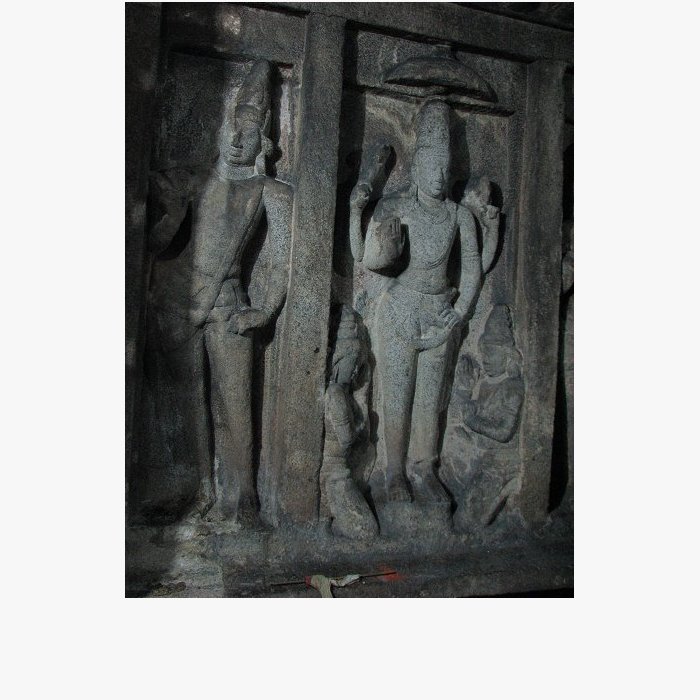
Adi Varaha Temple, Mahabalipuram, Tamilnadu
Harihara
To the right of the garbagriha is
a Harihara sculpture in a niche, similar to the Vishnu sculpture.
Here too, there are two devotees kneeling at the feet of the Lord.
Harihara is part Vishnu (on the left) & part Siva (on the right).
There is an inscription above this panel listing the Dasavatarams.
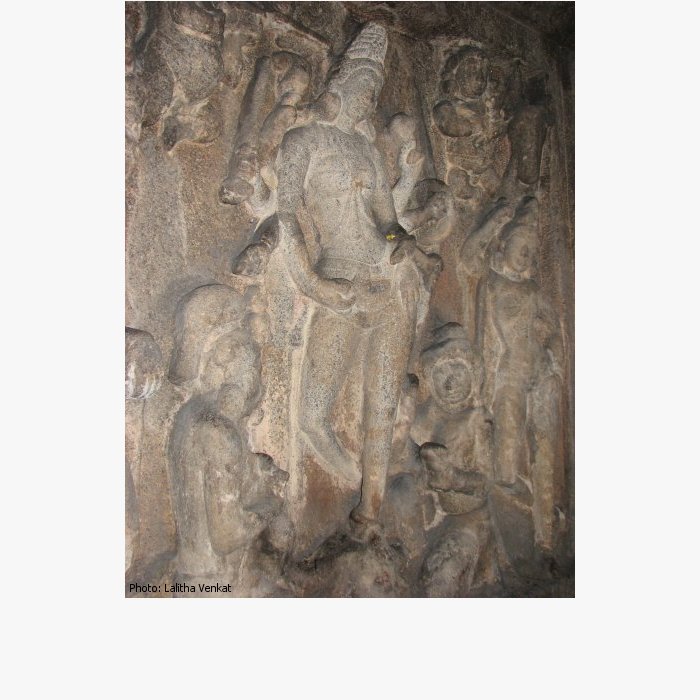
To the right of this is a panel depicting
Goddess Durga. Here the Goddess is in a graceful pose, with
her right leg bent slightly at the knee and crossed behind the left. (In
the other caves, we see Durga standing erect). In her eight arms
she holds weapons. On either side are two standing devotees with
weapons. At her feet are two sitting devotees. At the top we
can see two ganas, and the face of a lion and a deer on either side.
Adi Varaha Temple, Mahabalipuram, Tamilnadu
Goddess Durga
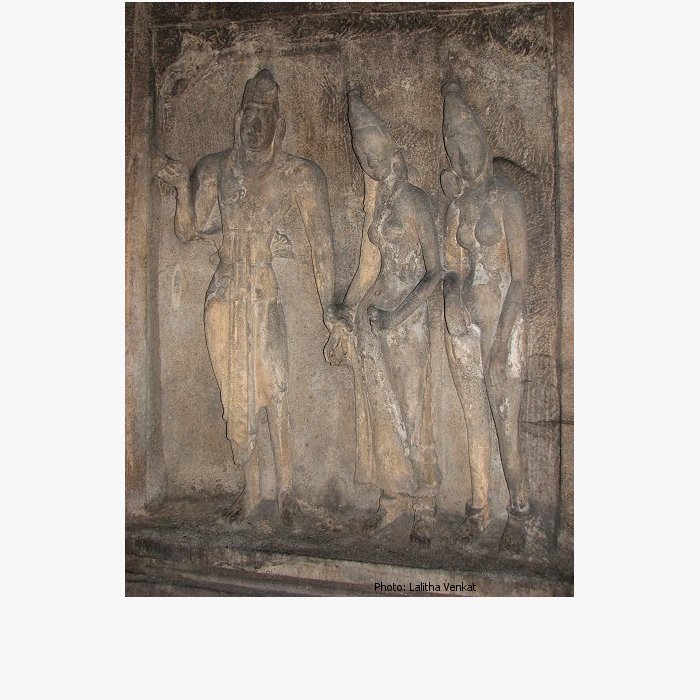
Adi Varaha Temple, Mahabalipuram, Tamilnadu
Pallava king with his two queens
To the right of this on the side
wall is a panel depicting a Pallava king with his two queens, both
of them on his left. In this panel, they are all seen standing.
An inscription above says Sri Mahendra pottr athirajan.
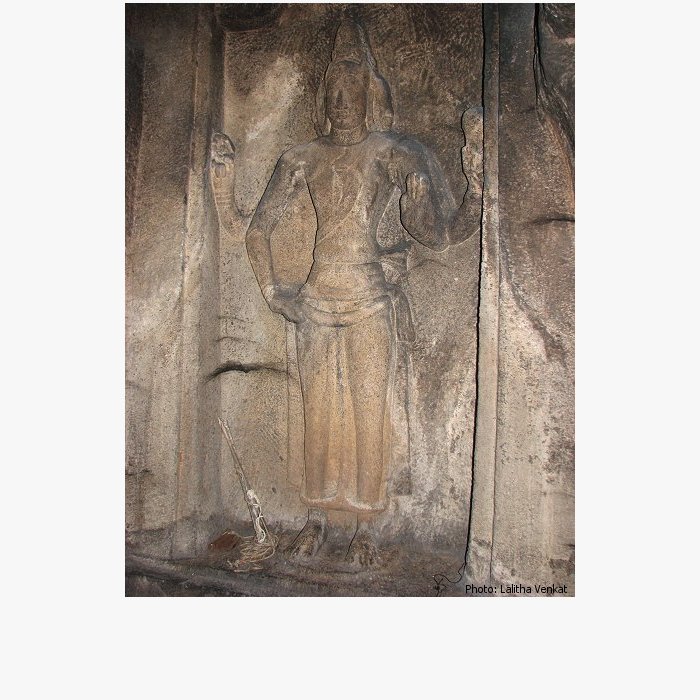
To the right of this, is a panel
depicting Lord Brahma seen standing on a lotus. His main right
arm rests on his hip while his left arm is in abhaya mudra. In his
upper right arm he holds the mala (rosary) and in his upper left arm a
lotus.
Adi Varaha Temple, Mahabalipuram, Tamilnadu
Brahma
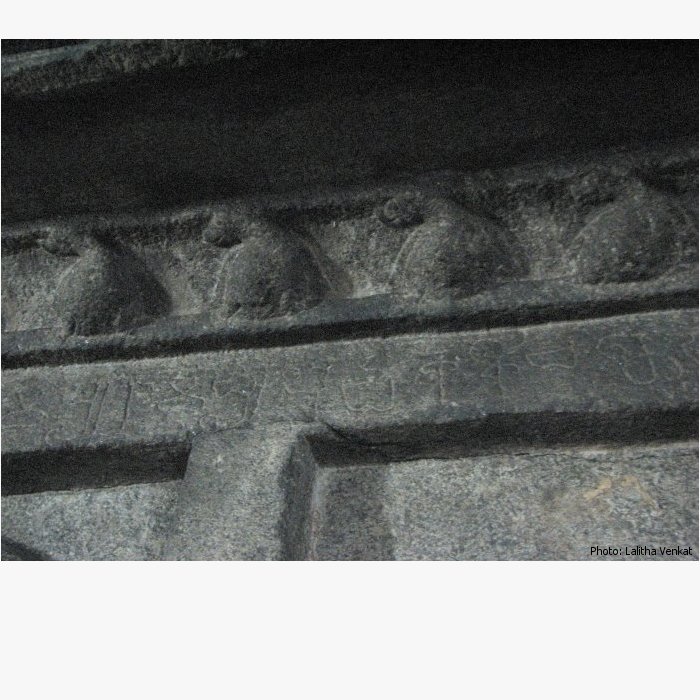
Adi Varaha Temple, Mahabalipuram, Tamilnadu
inscription
A two-line inscription, a sloka
in Sanskrit in the Pallava Grantha script can be seen on the floor of the
ardha-mandapam, cursing those who are not devotees of Siva.
Dr.Swaminathan, retired professor from IIT Delhi had organized a trip
to Mahabalipuram to understand and appreciate better the great art
treasures gifted to us by the Pallavas.
We visited only a few mandapams and caves, but at every spot
Mr.Swaminathan shared with us details such as - the Pallava kings who
had contributed, the structural variations / refinement that can be
observed in the structures belonging to different periods. And sadly,
also the vandalism - mostly broken noses, attempt to project a Siva
temple as a Vishnu temple or vice versa and also an attempt by the kings
to take credit without contributing. Since several Pallava rulers seem
to have shared the same titles, that further adds to the confusion.
Mr.Swaminathan first gave a general introduction to the temple
architecture and sculpture - the different styles of rock architecture
seen at Mahabalipuram - the monoliths, cave mandapams, structural
temple, bas relief.
|